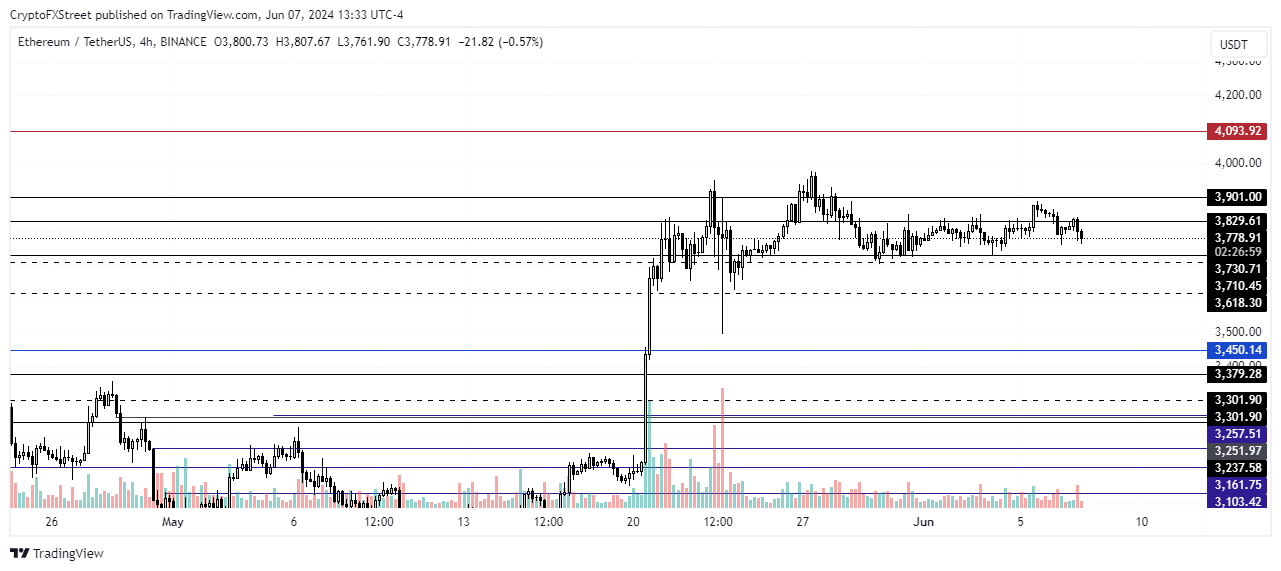- Hong Kong issuers are allegedly working toward incorporating staking into their ETH ETFs.
- ProShares submits 19b-4 application for spot ETH ETF.
- Ethereum will likely continue its range-bound movement over the weekend.
Ethereum (ETH) is down more than 3% on Friday following news that Hong Kong will allow issuers to integrate staking features into their spot ETH ETFs. ProShares also submitted a 19b-4 application for a spot ETH ETF with the Securities & Exchange Commission (SEC) on Thursday.
Daily digest market movers: Hong Kong ETFs, ProShares join the train
Ethereum ETFs are the main subject of discussions surrounding the number one altcoin. Here are the latest market movers:
- Hong Kong asset managers are allegedly working toward incorporating staking features into their spot Ethereum ETFs, according to Animoca Brands co-founder and Executive Chairman Yat Siu. Hong Kong crypto ETFs have struggled to garner investors’ attention despite the excitement surrounding their initial launch.
However, with the added rewards of staking, Hong Kong ETH ETFs could be attractive to investors worldwide, especially as the SEC has signaled that it won’t permit issuers to offer staking if/when spot ETH ETFs launch in the US.
Read more: Ethereum ecosystem active users spike 55% in Q1, 2x ETH ETF records impressive volume
- Asset manager ProShares submitted a 19b-4 form with the SEC on Thursday, stating intentions to issue spot Ethereum ETFs on the New York Stock Exchange (NYSE). The move puts ProShares as the latest member in the list of prospective spot ETH ETF issuers.
The SEC earlier approved the 19b-4 filings of eight issuers on May 23, including Van Eck, Bitwise, BlackRock, Fidelity, Franklin Templeton, Invesco & Galaxy, Grayscale and 21Shares. Following the approval, issuers submitted updated S-1 registration statements with the SEC, which the agency must approve before the ETFs go live.
Also read: Ethereum open interest surges by 50%, SEC Chair says ETH ETF launch will take more time
- SEC Chair Gary Gensler told Reuters on Wednesday that the timing for spot ETH ETFs to launch depended on how responsive issuers are to the SEC’s comment on their S-1s.
ETH technical analysis: Ethereum to sustain range-bound move over the weekend
Ethereum is trading around $3,781 as it continues its range-bound movement on Friday. The ETH long/short ratio is skewed toward shorts, with a 48% to 52% difference in the past 24 hours, according to data from Coinglass. This indicates a slight bias towards a bearish view, especially as ETH’s long liquidations are at $52.14 million compared to $7.37 million of short liquidations.
Read more: Ethereum leveraged ETFs go live as price fails to react
Considering current market conditions, Ethereum will likely stay above the $3,730 support.
ETH/USDT 4-hour chart
However, higher bearish sentiment will see the $3,618 support become the next key price to watch out for. ETH may sustain the horizontal move over the weekend and before beginning another attempt toward the $3,901 resistance.
A successful move above the resistance will see ETH begin a move to tackle the $4,093 yearly high before aiming for a new all-time high.
A daily candlestick close below the $3,300 level will invalidate the bullish thesis.
Ethereum FAQs
Ethereum is a decentralized open-source blockchain with smart contracts functionality. Serving as the basal network for the Ether (ETH) cryptocurrency, it is the second largest crypto and largest altcoin by market capitalization. The Ethereum network is tailored for scalability, programmability, security, and decentralization, attributes that make it popular among developers.
Ethereum uses decentralized blockchain technology, where developers can build and deploy applications that are independent of the central authority. To make this easier, the network has a programming language in place, which helps users create self-executing smart contracts. A smart contract is basically a code that can be verified and allows inter-user transactions.
Staking is a process where investors grow their portfolios by locking their assets for a specified duration instead of selling them. It is used by most blockchains, especially the ones that employ Proof-of-Stake (PoS) mechanism, with users earning rewards as an incentive for committing their tokens. For most long-term cryptocurrency holders, staking is a strategy to make passive income from your assets, putting them to work in exchange for reward generation.
Ethereum transitioned from a Proof-of-Work (PoW) to a Proof-of-Stake (PoS) mechanism in an event christened “The Merge.” The transformation came as the network wanted to achieve more security, cut down on energy consumption by 99.95%, and execute new scaling solutions with a possible threshold of 100,000 transactions per second. With PoS, there are less entry barriers for miners considering the reduced energy demands.
Source
